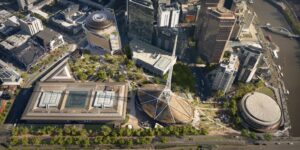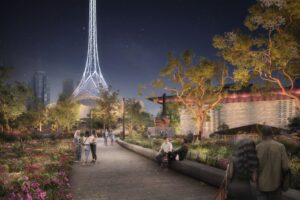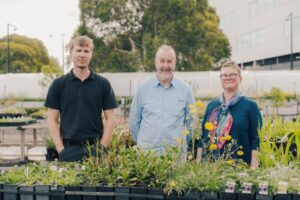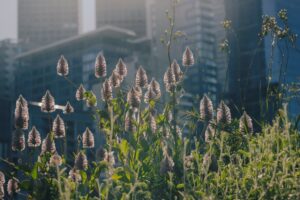
Naturalistic planting takes centre stage
By Gabrielle Stannus
The Melbourne Arts Precinct Transformation is a once-in-a-lifetime opportunity to reimagine that city’s cultural hub. Encompassing The Fox: NGV Contemporary, the major refurbishment of Arts Centre Melbourne’s Theatres Building, this major infrastructure project will also oversee the creation of Laak Boorndap, a new 18,000m2 urban garden. I spoke with Jon Hazelwood, Associate Professor Claire Farrell and Russell Larke to find out how this garden is being realised, and what it might mean for the broader horticultural industry.
The name Laak Boorndap, ‘Heaven’s Beauty’, was bestowed upon the garden by Wurundjeri Woi Wurrung Language Elder, Aunty Gail Smith. Laak Boorndap is an ambitious attempt to create more space for nature in Melbourne. Designed by the Melbourne studio of international design practice Hassell and New York’s SO-IL, in collaboration with internationally renowned horticulturists Nigel Dunnett and James Hitchmough, and local plant expert Jac Semmler from Super Bloom, this new urban garden will blend native and exotic plantings in a naturalistic style.
Jon Hazelwood, Landscape Architect and Hassell Principal, told me that the brief the consortium received was to design a completely new space for Melbourne, saying, “The Melbourne Arts Precinct is an international location with a very diverse range of people coming to enjoy that space. The Melbourne Arts Precinct Corporation (MAP Co) wants it to feel activated without it being programmed all the time, a continuously flowering space for people, art and performance.
“When we first started six years ago (speaking of a naturalistic style garden), everyone had in mind a European or American vision of perennial plantings. We were very clear from day one that it was not going to be that. We needed to come up with a planting style unique to this place, drawing on all collaborators’ knowledge of Australian flora, including Jac Semmler and the University of Melbourne, as well as other experts.

“We want to make Laak Boorndap a place filled with nature, albeit a highly designed nature, that people want to keep coming back to. They may know nothing about plants, and do not care what the species is. Ultimately, the garden will be about the spectacle; it is an artistic installation. The garden, therefore, needs to be in constant change and flux.”
The project team has also worked closely with Traditional Owners, the Wurundjeri Woi Wurrung, to incorporate their ideas. “They have been meaningful conversations,” says Jon of his time working with Elders Aunty Di Kerr, Aunty Gail Smith, and Aunty Julieanne Axford, “They wanted us to fully endorse the whole of nature in an immersive garden, the idea that visitors can touch, feel and even pick the plants. They also wanted us to include several totemic plants that are important to them, including a Manna Gum (Eucalyptus viminalis) and the Murnong (Microseris lanceolata).”
Incorporating trees into the Laak Boorndap landscape will be challenging, given it will be installed on what is essentially a green roof. Jon explains that the original precinct podiums from the sixties and seventies have weight loading restrictions, restricting soil depth, which has turned out to be both a disadvantage and an advantage: “This limitation favours many of the perennial plants and the Western Plains grasses, the latter of which grow on very impoverished, low organic soil anyway. In the trade, all our soils have way too much organic matter in them anyway, so actually having the restriction of these free-draining, low organic, quite shallow depth soils are probably right for the local flora and fauna as well.”

Melbourne Arts Precinct Plant Trials
The plants that will eventually be grown at Laak Boorndap must be compatible with Melbourne’s changing climate, flourish year-round, remain beautiful and ever-changing, whilst continuously fostering biodiversity. The University of Melbourne is leading a three-year plant trial at its Burnley campus to evaluate plant species and mixes best suited to thrive in Laak Boorndap. The plants are being tested on the Burnley roof garden in beds with shallow substrate, and with minimal irrigation, to mimic the environment of Laak Boorndap. The plant trials are being led by Associate Professor, Claire Farrell and Research Fellow, Dr Dean Schrieke.
According to Claire, the plant trials were flagged very early on in the design process. “We are testing ecological theory whilst also informing planting design for the precinct. The reason we must do that approach is we cannot test every plant combination given the scale of the project. Initially we were going to look at plant water use in a glasshouse setting. However, by the time the program started, we had already completed similar experiments for other research projects. So, we decided to screen as many plants as we could on the Burnley green roof. From those test results, we will then design mixtures in which we can then trial different plant types and their response to those substrates. Our roof-top trial is currently testing 76 species, whilst we have another 50 geophytic species being tested separately in the Burnley nursery. We will use the initial data to make functional plant groups consisting of species with similar trait combinations and tailor the mixtures to suit those.
“We are currently in the first year of the trials. We are conducting experiments to observe how plants respond to differences in resource availability at different substrate depths. At the Melbourne Arts Precinct, there will be a lot of new structure which will allow for deeper substrates, anything from half a metre to a metre, providing opportunities for tree planting and the like. However, much of the existing structure will be reused, including that around Hamer Hall which is much shallower and more suited to drought resilient grasses, herbs and succulents.

“We are growing plants in 10, 15 and 20-centimetre-deep substrates, so we can see how growth, flowering and survival patterns vary in different settings. Some plants will do the same thing regardless of substrate depth. However, we have other plants that are upregulated when they have access to more resources, so they flower and grow more. We will then place plants together in functional groups in the test mixtures; fundamentally it will be putting the slow plants together, the fast plants together, and then mixing both and seeing how you go with competition or facilitation.”
The plants being trialled in a green roof setting are ostensibly a mix of herbaceous perennials from Mediterranean climates such as the exotic Cistanthe grandiflora (Rock Purslane), Crithmum maritimum (Rock Samphire), Symphyotrichum spp. (formerly Aster), Salvia yangii (Russian Sage, formerly Perovskia atriplicifolia), Salvia nemorosa (Woodland Sage) and Tulbaghia violacea (Society Garlic). Native plants include Poa clivicola (Fine-leaved Snow-grass), Craspedia aurantia var. jamesii (Orange Billy Buttons) and Veronica nivea (Milfoil Speedwell), the latter a soft, woody shrub listed as endangered in Victoria1[GS1] and propagated by Raising Rarity, a community-based outreach program run by the Royal Botanic Gardens Victoria.
The second experiment that the Burnley team is currently carrying out is comparing summer versus winter dormant geophytes to determine flowering and foliage patterns under a repeated irrigation regime. “We want to see which of these plants persist,” says Claire, of the plants being grown in modules in the Burnley nursery. Tuberous geophytes featured in this experiment include Cyclamen coum (Eastern Sowbread), native to Bulgaria, the Caucasus and Israel, and Gladiolus salmoneus (Cottage or Salm Gladiolus) from South Africa. Bulbous perennials include Nerine spp. (Guernsey or Spider Lilies).
First year trial results so far are varied. “We are pushing to drier climate bulbs; however, they are all so different and I do not think they are behaving like they should either,” says Claire, “Some plants have not really gone dormant when they were meant to, but that is kind of exciting. I think that is consistent across the rooftop trial on the roof and in the modules. The flowering is not matching up with published flowering. A big part of the trial is looking at growth and flowering. The design of Laak Boorndap is based on a year of wonder, this idea that there will be something interesting all the time, changing with the seasons. And so, quantifying the flowering is a big part of our research.”
Test Garden
The Burnley plant trials are not the only location where Laak Boorndap is being tested well ahead of its opening day, several years away. A pop-up Test Garden was installed in the Skyline Car Park at Federation Square in February. Designed by Hassell in partnership with Jac Semmler, James Hitchmough and Nigel Dunnett, the Test Garden was constructed by the Colombo Design Partnership, with Arbornet supplying plants. This demonstration garden allows its visitors to get a taste of the naturalistic planting style of Laak Boorndap and provides a test bed for programming, research and conversations about climate change, biodiversity and ecology.
It takes a special type of gardener to manage not only this Test Garden, but also Laak Boorndap as it proceeds from design to installation over the next couple of years. MAP Co recently appointed Russell Larke as Laak Boorndap’s Head Gardener. Russell has extensive horticultural experience, most notably his previous appointment as a Senior Curator at the Royal Botanic Gardens Victoria – Cranbourne, where he managed the Australian Garden which focused on the display and conservation of southeast Australian plants.

“You honestly had to get a crowbar to get me out of Cranbourne. I absolutely loved that place; there are only six or seven curator jobs like that in the country,” says Russell, “I have become increasingly obsessed with connecting people to plants, and not only people who are rusted [sic] on horticulturalists and conservationists, but trying to cure plant blindness and a lack of connection to nature. I just felt that Laak Boorndap is an opportunity to be part of something that can transform the way people feel about plants and nature, and how they can modify cities or even change their own garden.
“This garden is quite a different type of landscape that has rarely been seen in the southern hemisphere. There is more of this type of naturalistic planting going on in the northern hemisphere. This is groundbreaking in a horticultural sense, especially on a scale like this. In the Test Garden, the naturalistic style of planting is evoking a different response in people. They are not just walking past and looking at the garden, they are really interacting with it. They take selfies and want to pick and smell things, look at the bees and birds.
“Jac and Hassell wanted to build a garden that is interesting seasonally. There are a couple of different Ptilotus species, Ptilotus macrocephalus (Featherheads) and P. exaltatus (Pink Mulla Mulla). I have cultivated these at Cranbourne and in my own garden. However, I have never seen them in this type of naturalistic style garden. They look awesome. People love them. They have been the summer highlight for this garden. They are absolutely divine! And recently, the pink Nerine bowdenii has started to pop up; they are only in flower for a couple of months in autumn. They are starting to float throughout the garden. They are probably my two favourites, for their impact on the garden.”
These plants are only three of over 70 native and exotic species planted in the Test Garden; the type and diversity of this planting scheme requiring even an experienced gardener such as Russell to stay on his toes. “With so many plants in such a big landscape like that of Laak Boorndap, you are never going to get it a hundred percent right. There has been some pruning of the dominant species, plants like Cistanthe grandiflora (Rock Purslane) and Isotoma axillaris (Rock or Showy Isotome). In just three months, these two species are slightly more competitive than other plants given the current irrigation regime. So, you must think carefully about how you are going to use them in the mix. I have been doing some work to ensure that new bulbs can come through, and some of those other species that you are not seeing as much have room to grow, and they are not getting shaded out or out competed. There are species that are already underperforming. On a large scale, you probably would not plant them.
“As a gardener, you must make design decisions constantly. You are managing the system. You must maintain the structure; however, there are all these opportunities to free flow as a gardener. It is not like a hedge where if one plant dies, you go and get another six-inch pot to replace it. I have been replanting Bulbines and grasses, nicking out succulents and dropping them in gaps, cutting out other species to allow seasonal variation. It is a fun way of gardening, and it is more forgiving. There is not a gardener on the planet that has not lost a plant. Here, however, if you lose one plant, you have some options for its replacement including self-seeding or suckering or clipping and planting succulents.”
Changing expectations
Russell hopes that through his work in the Test Garden, and then at Laak Boorndap, that he can contribute to the horticultural knowledge to help others to replicate, establish and manage similar landscapes in the future. “Given the impact that the Test Garden has had so far, I can only imagine what the impact of Laak Boorndap on the industry and the public will be; an 18,000m2 garden of naturalistic plantings. The Test Garden has not only captured the public’s imagination; I think the industry is really looking to it to learn about this style of planting. They are excited about its scale and what it means for Melbourne.”
Claire agrees: “In the longer term, Laak Boorndap will shift people’s attitudes to public landscapes and expectations around them as well. I think for this project to be about the garden and then the buildings, rather than the other way round, might shift public plantings as well, for example the proportion of hardscape versus garden.”

Valuing professional gardeners differently
Claire also thinks that Laak Boorndap will shift how horticulture as a profession is viewed, including the skillset and pay for positions where gardeners need to ‘care’ for a planting. She says the horticultural experience that will be required at this garden is not just “mow and blow”, given the need to ensure that it provides ‘wonder’ throughout the year.
Russell agrees with Claire, emphasising the difference between someone who mows a lawn and someone who establishes a garden: “I think people think that if they can prune or slash plants, or mow grass that that makes them a gardener. Our trade is somewhat devalued in people’s eyes. A plumber can come in and charge you 200 bucks an hour, and you say, ‘Fair enough’. If you were to do that as a gardener, people would have a heart attack.”
“Something must change in how these landscapes are managed,” Jon adds, “It cannot just be slash and mow because there is a skill-set around sorting out the seedling from the weedling. I am hoping that this project will help those conversations because a lot of it is going to be about how Laak Boorndap is managed as much as it is about what it looks like on day one.”
Plant availability
Currently, the team’s more immediate challenge is finding the number and type of plants that they want for installation, something that Jon is very mindful of. “If we do not specify it, growers will not grow it. However, if growers do not grow it, we cannot specify it. We really struggled to get the mix of plants we wanted for the Sydney Metro trial we did five or six years ago,” Jon says, adding though that things are changing in the industry. “In a recent job we just completed, there was only one substitution from the whole plant list. Plants like vanilla lilies, Arthropodiums and Bulbines are much easier to find in New South Wales now. With Laak Boorndap, the industry can hopefully see the opportunities in it. I do not think it will be long before we see those Pink Calandrinia (Cistanthe grandiflora) appear in Bunnings. Everyone loves them!”
“Laak Boorndap is going to have a big impact on plant availability. I think it will expand what is available and at what scale,” says Claire, “I think the other thing this garden will probably do, and you can already see this filtering through the Melbourne International Flower and Garden Show, is challenge people to mix natives and exotics together, in a more naturalistic way.”
Looking ahead
Whilst Laak Boorndap is still several years away from completion, Jon is already thinking ahead to its long-term management. “Whatever we propose now is not going to be what is there in ten years’ time. We are going to have to let our ego go, and hand it all over to Russell as the Head Gardener and the team to have that artistic approach, and that it will change over time.”
No doubt, we will see a very different type of landscape management in place at Laak Boorndap when it is realised. But do not take my word for it! If you have not already, I would highly encourage you to visit the Test Garden to get a sense of what Laak Boorndap will become. I have a sneaking suspicion that this temporary garden may become more permanent, given its popularity with visitors thus far. If that happens, I think another name will be needed to define this ‘parklet’. In the meantime, I eagerly await the opening of Laak Boorndap, and the transformation of the Melbourne Arts Precinct.
Gabrielle Stannus
Inwardout Studio
M: 0400 431 277
E: gabrielle@inwardoutstudio.com
